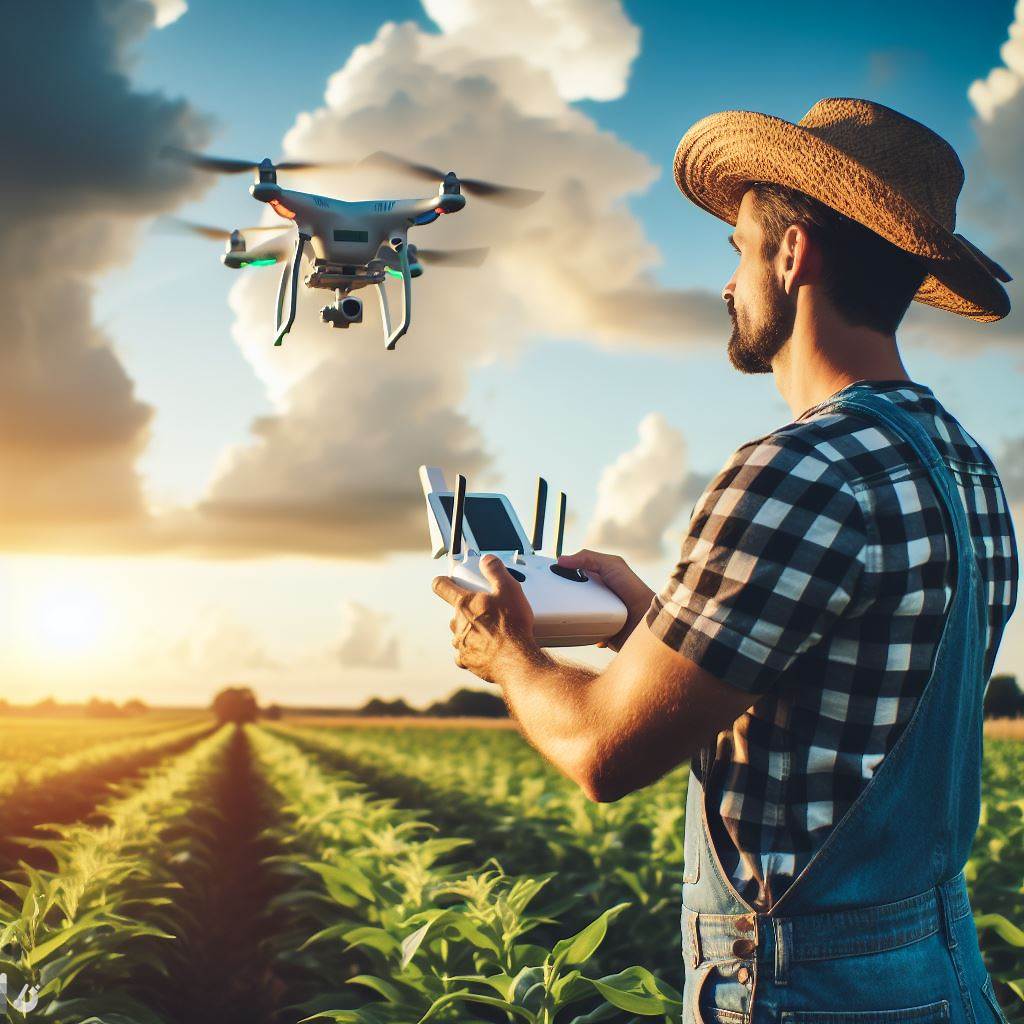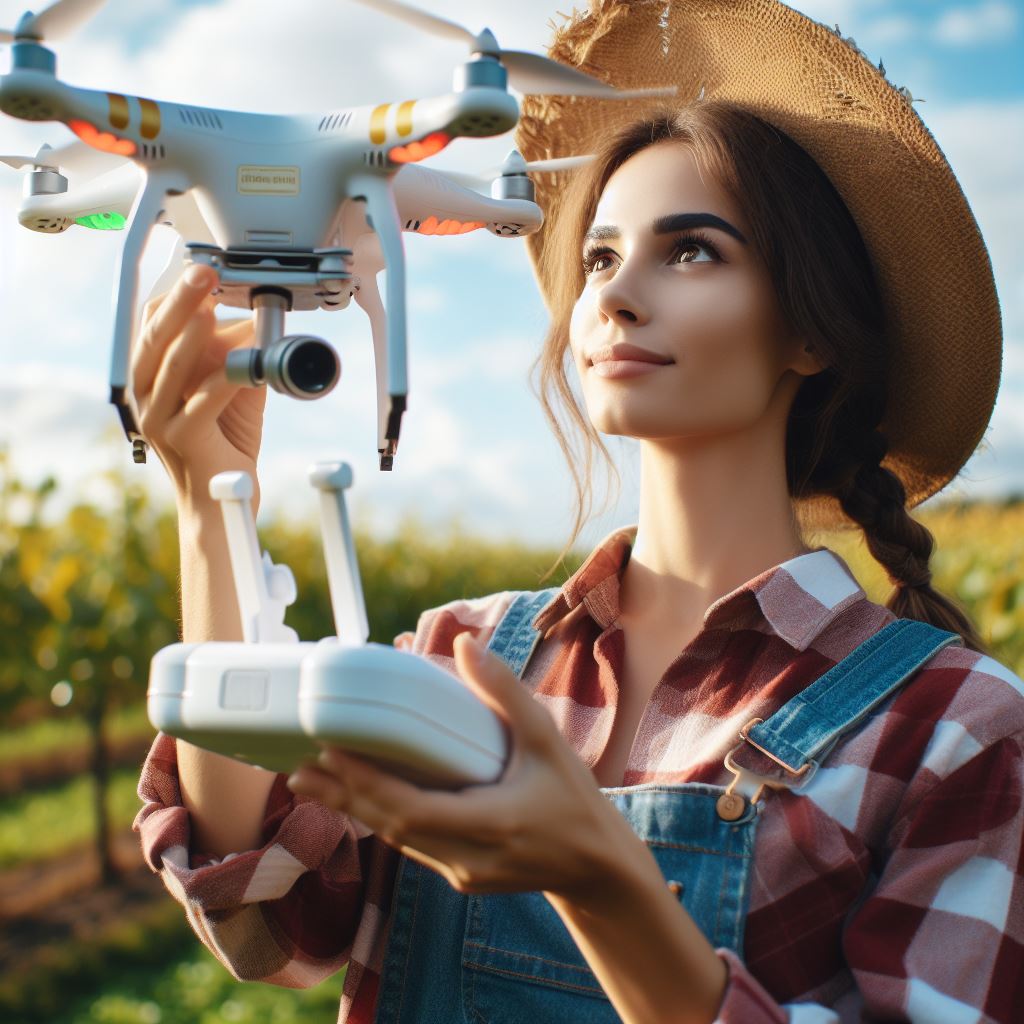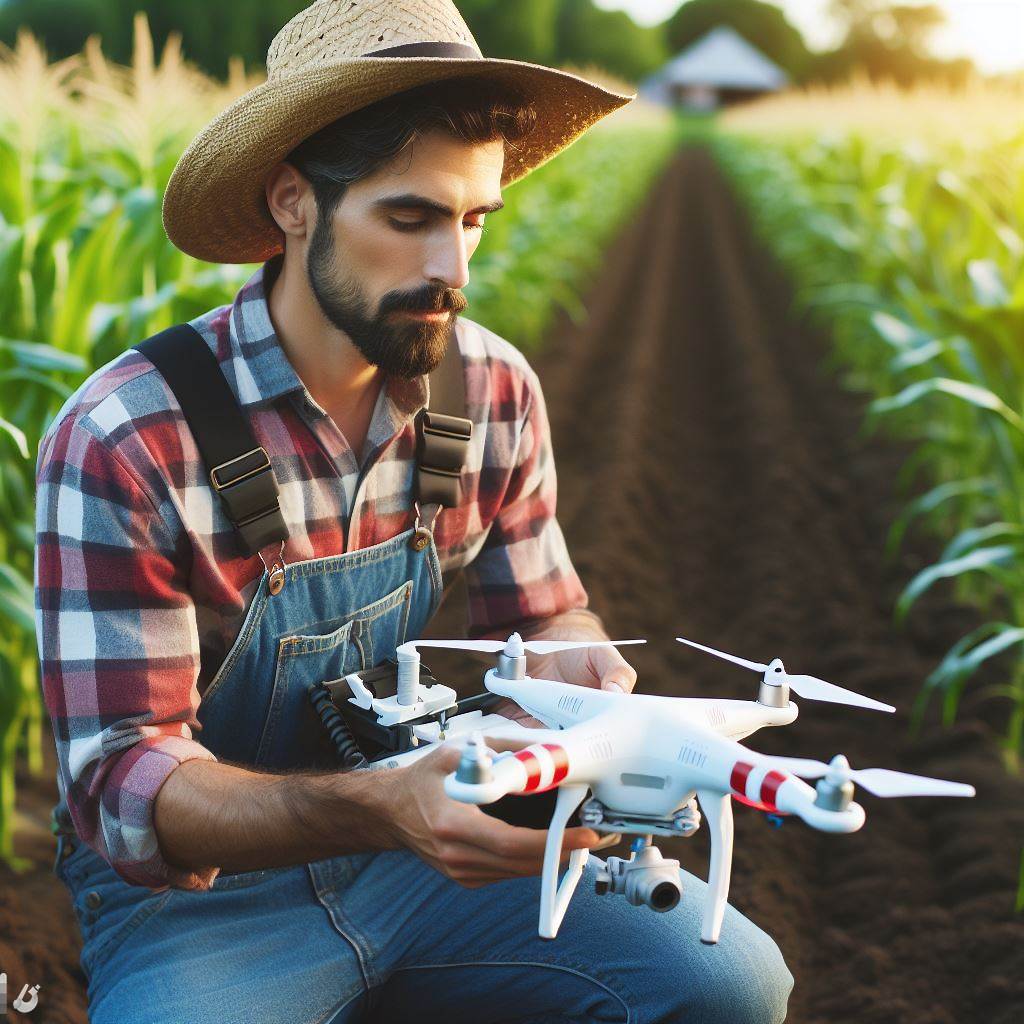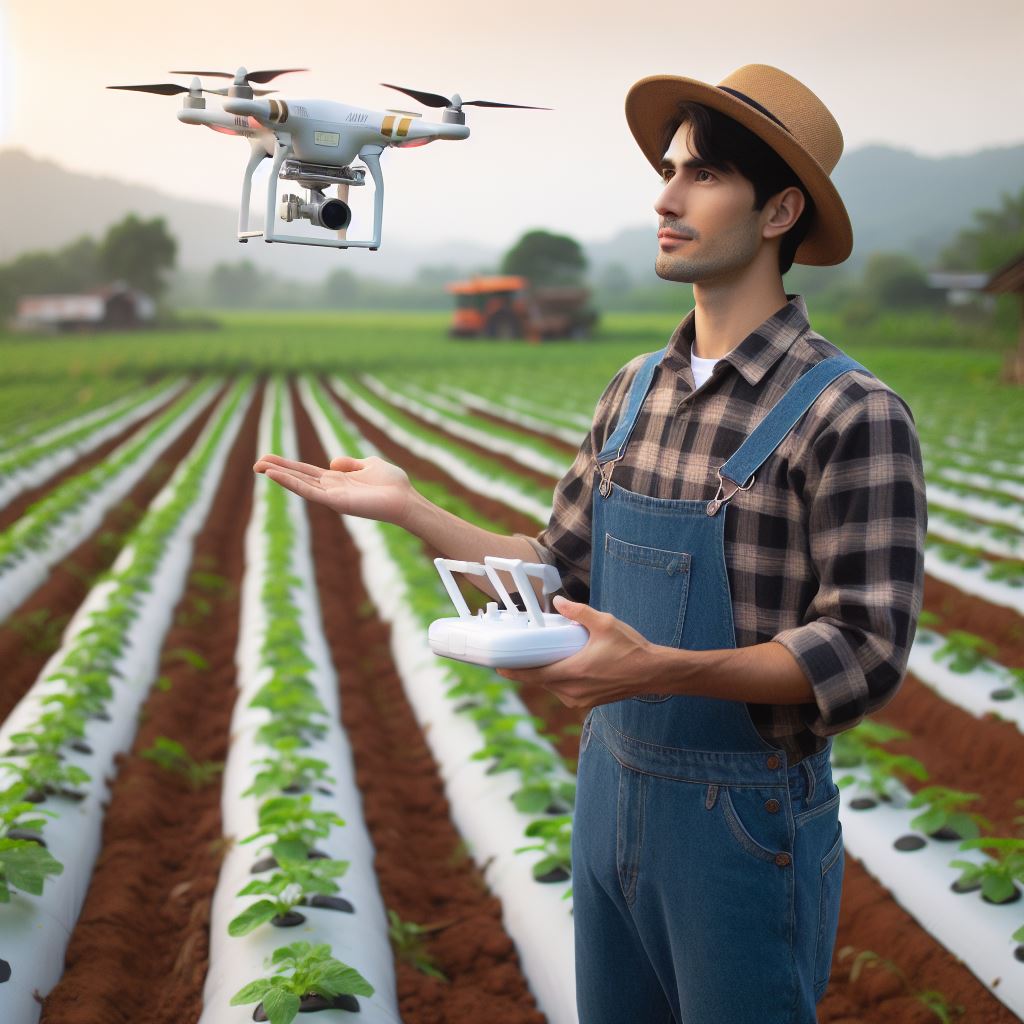Introduction
Crop monitoring plays a crucial role in farming as it helps farmers assess the health and productivity of their crops.
However, the traditional methods of crop monitoring can be time-consuming and labor-intensive.
Transitioning to the use of drones in crop monitoring has revolutionized the farming industry.
Benefits of Drones in Crop Monitoring
Drones enable farmers to monitor their crops more efficiently and effectively.
With high-resolution cameras and sensors, drones can capture detailed images and collect precise data.
This data can be used to detect crop diseases, nutrient deficiencies, and pest infestations early on.
By identifying problems at an early stage, farmers can take prompt measures to prevent large-scale crop loss.
Drones also help farmers in irrigation management by providing moisture content information.
This enables farmers to optimize water usage, reducing water wastage and promoting sustainable farming practices.
Additionally, drones can cover large areas of farmland quickly, saving time and effort for farmers.
Challenges and Future Prospects
Despite the numerous benefits, the use of drones in crop monitoring is not without challenges.
Regulations and restrictions regarding drone usage need to be considered and complied with.
Privacy concerns and potential risks of unauthorized access to farm data must also be addressed.
However, advancements in drone technology and data analysis algorithms hold great potential for the future.
Integrating drones with artificial intelligence and machine learning can further improve crop monitoring accuracy.
Transform Your Agribusiness
Unlock your farm's potential with expert advice tailored to your needs. Get actionable steps that drive real results.
Get StartedThe cost of drones and the necessary training for farmers to operate them effectively are also important considerations.
Basically, the use of drones in crop monitoring has revolutionized farming practices.
With their ability to gather detailed data quickly, drones provide farmers with valuable insights for better decision-making.
Though challenges exist, the ongoing advancements in drone technology offer promising prospects for the future of farming.
The Benefits of Drones in Crop Monitoring
In today’s rapidly evolving agricultural landscape, the integration of drones in crop monitoring has revolutionized farming practices.
The benefits offered by these unmanned aerial vehicles are transforming the way farmers manage their crops and make decisions.
Let’s delve into the advantages of using drones in crop monitoring.
Increased Efficiency
One of the key advantages of using drones in crop monitoring is their ability to cover large areas of farmland quickly.
Traditional methods of surveying fields involve manual labor and intensive hours.
Drones, on the other hand, can fly over vast stretches of land in a fraction of the time, saving valuable resources.
Furthermore, drones equipped with advanced sensors and imaging technology collect real-time data, providing farmers with up-to-date information about their crops.
This data can be analyzed immediately, allowing farmers to detect and address potential issues promptly.
By obtaining accurate and timely information, farmers can make informed decisions that optimize their crop management strategies.
Cost-effectiveness
Implementing drone technology in crop monitoring contributes to cost-effectiveness.
Transform Your Agribusiness Online Presence
Stand out with compelling content tailored to engage your audience and drive results. From blog posts to social media, we’ll create what your business needs to grow.
Get StartedBy replacing manual labor with drones, farmers can decrease their workforce and lower labor costs substantially.
Additionally, drones eliminate the need for expensive machinery, reducing equipment costs.
These cost savings can be significant for farmers, particularly those operating on large-scale farms.
The use of drones also enables the optimized use of resources.
By precisely monitoring crop health and growth, farmers can apply resources like water, fertilizers, and pesticides only where they are needed.
This targeted approach minimizes resource wastage and prevents unnecessary expenses.
With drones, farmers can achieve higher resource efficiency and financial savings simultaneously.
Precision Agriculture
Drones play a crucial role in enabling precision agriculture.
Their ability to capture high-resolution imagery allows farmers to identify specific areas within crops that require attention.
For instance, if a particular area is affected by pests, drones can detect it early on and help prevent the infestation from spreading.
Similarly, drones can detect nutrient deficiencies in specific sections of a field, enabling farmers to apply fertilizers only where they are needed.
The data collected by drones not only helps identify problems but also enables targeted resource application.
By knowing precisely which areas need intervention, farmers can allocate their resources efficiently.
This focused approach minimizes the overall use of inputs while maximizing output, resulting in better crop health and higher yields.
Unlock Farming Insights for Growth
Make smarter farming decisions with detailed reports on market trends, weather patterns, and soil health tailored to your farm's success. Boost productivity with actionable data.
Get ReportGenerally, the benefits of integrating drones into crop monitoring cannot be overstated.
Drones enhance efficiency by covering large areas quickly and providing real-time data.
They contribute to cost-effectiveness by reducing labor, equipment, and resource costs.
Furthermore, drones enable precision agriculture by identifying specific areas requiring attention and facilitating targeted resource application.
With drones revolutionizing farming practices, their adoption is poised to continue growing in the agricultural industry.
Read: Drones in Agri: Irrigation Game Changer
Applications of Drones in Crop Monitoring
Drones have revolutionized the farming industry by providing crucial insights and data for crop monitoring.
With various applications, farmers can now enhance their productivity and reduce risks through early identification and analysis.
Pest and Disease Detection
One important application of drones in crop monitoring is the detection of pests and diseases.
By capturing aerial imagery of the fields, drones can provide early identification of potential threats to the crops.
Aerial imagery allows farmers to have a broader and more comprehensive view of their fields, enabling them to detect pests or diseases even in the early stages.
This early identification is crucial as it allows farmers to take proactive measures to mitigate the potential damage and reduce the need for extensive pesticide use.
Moreover, when integrated with AI and machine learning, drones can analyze the captured imagery to accurately identify pests or diseases.
This integration enhances the accuracy of detection and enables farmers to make informed decisions about appropriate treatment and control measures.
Crop Growth Monitoring
Another significant application of drones in crop monitoring is assessing plant health and growth patterns.
By regularly capturing aerial images or using multispectral sensors, drones can provide farmers with essential insights into the overall health of their crops.
Drones equipped with multispectral sensors can capture data beyond what is visible to the naked eye.
These sensors can measure plant vigor, chlorophyll levels, and other indicators of crop health.
By monitoring these parameters, farmers can identify any growth abnormalities and take necessary actions to optimize crop performance.
Monitoring yield potential is also crucial for farmers to optimize their production and make informed decisions on resource allocation.
Drones can capture high-resolution images throughout the growing season, allowing farmers to track the development of their crops and estimate potential yields.
Irrigation Management
Irrigation plays a vital role in crop production, and drones can significantly contribute to efficient irrigation management.
By utilizing drones, farmers can perform moisture mapping in their fields to identify areas with varying levels of moisture content.
Through thermal imaging and other advanced sensors, drones can detect variations in soil moisture, highlighting areas that require additional irrigation or drainage.
This information helps farmers optimize their irrigation schedules, preventing over- or under-irrigation, which can lead to water wastage or crop stress.
By precisely mapping moisture levels, drones enable farmers to target irrigation efforts and conserve water resources.
This not only benefits the environment but also helps farmers reduce operational costs related to water usage.
Essentially, the applications of drones in crop monitoring are transforming the farming industry.
From pest and disease detection to crop growth monitoring and irrigation management, drones provide invaluable data and insights for farmers to enhance productivity and sustainability in their farming practices.
Embracing this technology can revolutionize farms, making them more efficient, precise, and profitable.
Read: Agri-Drones: Changing the Face of Farming
Technological Advancements in Drone Technology
With the rapid advancement of technology, drones have revolutionized the way farms are monitored and managed.
The integration of drones in crop monitoring has provided farmers with valuable insights, increased efficiency, and improved yields.
In this section, we will explore the technological advancements in drone technology that have contributed to this agricultural revolution.
Improved Sensors and Cameras
One of the key advancements in drone technology is the improvement of sensors and cameras.
Drones now offer high-resolution imagery and multispectral capabilities, allowing farmers to obtain detailed information about their crops.
The ability to capture high-resolution images from above provides a clear view of plant health, growth patterns, and potential issues.
Additionally, drones equipped with thermal imaging capabilities can detect crop stress caused by diseases, pests, or water shortages.
This enables farmers to take timely action and prevent significant crop losses.
Autonomous Flight and Path Planning
Another significant development in drone technology is autonomous flight and path planning.
Drones can now navigate fields using GPS-guided navigation systems, flying along pre-programmed flight paths.
This eliminates the need for manual control, saving farmers time and ensuring complete coverage of their fields.
Moreover, drones can autonomously collect data and create maps of the crops, streamlining the monitoring process.
The data collected can be used to identify areas that require attention, improving resource allocation and overall crop management.
Integration with Agricultural Software
Drones have also become compatible with agricultural software, enhancing their functionality and providing farmers with valuable insights.
Data integration and analysis platforms allow farmers to efficiently process and visualize the data collected by drones.
This integration enables them to identify patterns, track changes, and make informed decisions about crop management.
Furthermore, agricultural software can generate recommendations based on the drone data, helping farmers optimize their agricultural practices.
By leveraging the power of drones and software integration, farmers can enhance productivity and reduce costs.
In general, the technological advancements in drone technology have paved the way for revolutionizing farms and crop monitoring.
Improved sensors and cameras provide farmers with detailed imagery and thermal imaging capabilities to detect crop stress.
Autonomous flight and path planning enable drones to navigate fields and collect data autonomously.
Integration with agricultural software allows for efficient data analysis and generates valuable recommendations.
With these advancements, drones have become indispensable tools for farmers, enhancing productivity, and ultimately leading to increased yields.
Read: Crop Monitoring: New Tech Insights
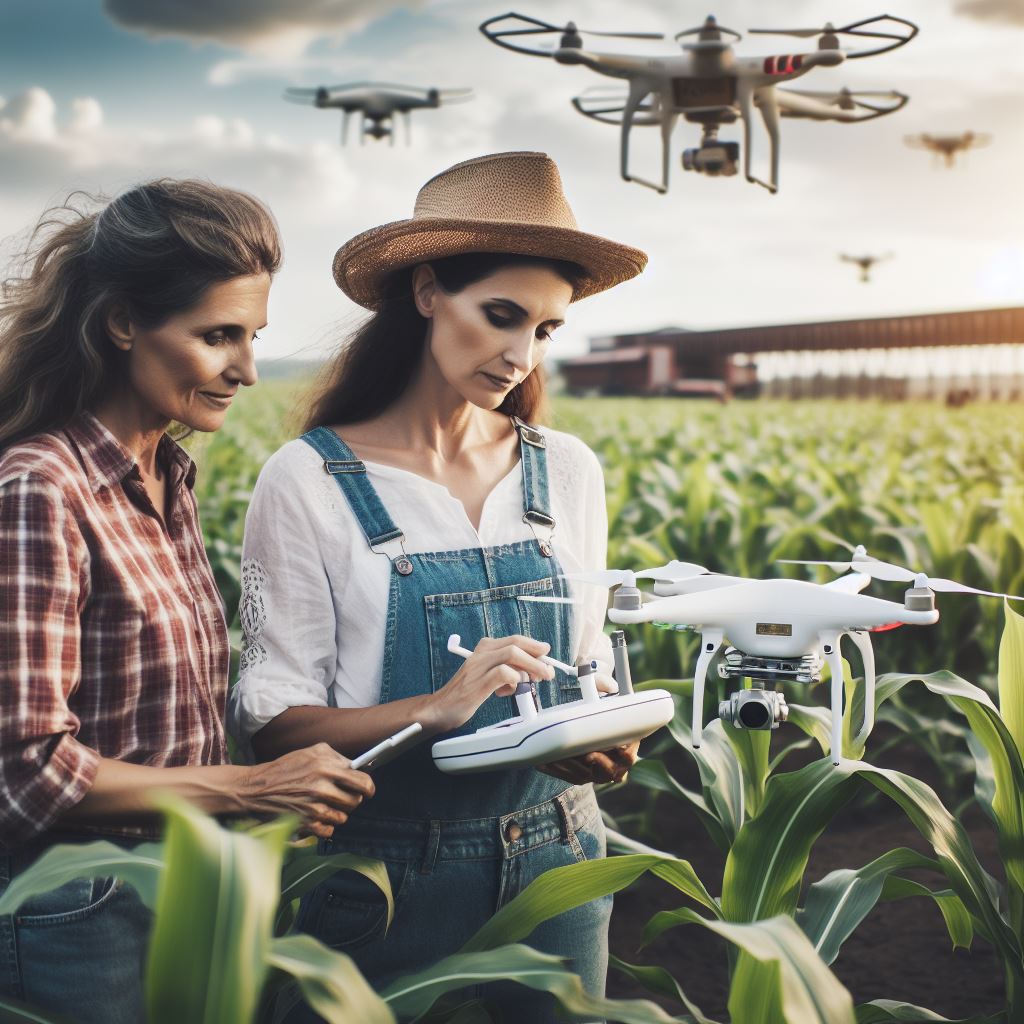
Challenges and Limitations
Revolutionizing farms with drones in crop monitoring brings about immense benefits and potential.
However, like any other technological innovation, it is not without its challenges and limitations.
In this section, we will explore the various obstacles that need to be overcome for a successful implementation of drone-based crop monitoring.
Regulatory Constraints
One significant challenge faced when incorporating drones in crop monitoring is the compliance with local aviation regulations.
Drones are subject to laws and regulations that govern their usage in airspace.
These regulations ensure the safety and proper operation of drones but can also pose barriers to their deployment in agricultural settings.
- Compliance with local aviation regulations can be complicated and time-consuming. Farmers and drone operators must navigate through a maze of legal requirements and restrictions.
- Furthermore, obtaining necessary permits and licenses to operate drones for agricultural purposes can be a cumbersome process.
This often involves submitting detailed applications and meeting specific criteria set by regulatory bodies, which can be time-consuming and costly.
Skill and Knowledge Gap
Another challenge to consider is the skill and knowledge gap associated with drone-based crop monitoring.
- Drone operators must undergo training and acquire the necessary skills to safely operate drones and efficiently manage flight missions. Knowledge of drone technology, flight principles, and operational procedures are essential.
- Additionally, data analysis and interpretation skills are crucial when utilizing drones for crop monitoring. Collecting vast amounts of data is meaningless without the ability to analyze and derive meaningful insights from it.
Weather Constraints
Weather conditions play a vital role in successful drone-based crop monitoring.
- Adverse weather conditions, such as strong winds, heavy rain, or storms, can hinder drone flight operations. These conditions may make it unsafe or practically impossible to conduct aerial surveys and data collection.
- Furthermore, unfavorable weather can significantly impact the accuracy and timeliness of the collected data. Poor weather conditions can affect image quality, crop visibility, and overall data integrity.
In a nutshell, while drones have the potential to revolutionize crop monitoring in agriculture, there are significant challenges and limitations that need to be addressed.
Regulatory constraints, skill and knowledge gaps, and weather conditions are among the key factors that can impede the widespread adoption and effective use of drones in this context.
However, with proper regulations, training programs, and advancements in drone technology, these obstacles can be overcome, paving the way for a more efficient and productive future in agriculture.
Read: Tech for Organic Farming in 2024
See Related Content: Hydroponics & Aquaponics: Tech Insights
Case Studies and Success Stories
Drones have revolutionized the way farms approach crop monitoring, offering numerous benefits and transforming traditional agricultural practices.
The following case studies and success stories highlight the positive outcomes achieved by farms that have embraced drone technology.
Examples of farms using drones for crop monitoring
Increased productivity and yield
Farms incorporating drones into their crop monitoring practices have observed significant improvements in productivity and overall crop yield.
Drones enable farmers to identify crop health issues promptly and take timely action, resulting in healthier plants and increased yields.
Enhanced pest management and disease control
Drones equipped with advanced sensors and imaging technologies have revolutionized pest management and disease control in agriculture.
By providing high-resolution images of crops, drones allow farmers to detect pest infestations and diseases at an early stage.
This early detection enables targeted interventions, reducing the need for excessive pesticide use and minimizing crop damage.
Testimonials from farmers
Positive impact on farming practices
Numerous farmers have praised the transformative impact of drones on their farming practices.
They emphasize how drones have revolutionized crop monitoring by providing real-time data on crop health, water stress, nutrient deficiencies, and other crucial factors.
This information allows farmers to make informed decisions and implement appropriate interventions promptly.
Economic and environmental benefits
The adoption of drones for crop monitoring not only enhances farm productivity but also brings economic benefits.
Drones significantly reduce labor costs as they are capable of covering larger areas in a shorter time compared to manual monitoring.
Moreover, the data collected by drones guides farmers in optimizing resource allocation, leading to improved efficiency and cost savings.
Furthermore, reduced pesticide use through targeted interventions contributes to a healthier environment and promotes sustainable farming practices.
These case studies and testimonials serve as powerful evidence of the advantages of using drones for crop monitoring.
The increased productivity, improved pest management, and the positive impact on farming practices highlight the value that drones bring to the agricultural sector.
As farms continue to embrace drone technology, it is crucial to recognize its potential and invest in further research and development.
The integration of artificial intelligence and machine learning algorithms can enhance the analysis of drone-aided data, providing even more precise and actionable insights for farmers.
In essence, the case studies and success stories demonstrate the transformative impact of drones in crop monitoring.
The increased productivity, enhanced pest management, and positive testimonials from farmers emphasize the potential of this technology in revolutionizing farming practices.
With drones, farmers can better monitor their crops, make informed decisions, and ultimately achieve higher yields while promoting economic and environmental sustainability.
Find Out More: Robotics in Organic Farming: Insights
Conclusion
Drones are revolutionizing farms by enabling precise, real-time crop monitoring.
As detailed throughout this post, drones equip farmers with aerial data to optimize crop health.
Drones can map fields, detect problems, and support data-driven decisions.
Embracing drone technology allows farmers to increase yields, reduce costs, and farm more sustainably.
Drones carry specialized cameras and sensors to collect crop data efficiently.
Multispectral imaging reveals plant stress and soil variation.
Thermal imaging spots irrigation issues. Lidar generates 3D maps of terrain and crops.
Drones cover ground faster than walking or soil sampling.
The regular, low-altitude flights enable consistent monitoring for changes over time.
The insight provided by drones is invaluable for modern, productive farming.
Early problem detection protects crop quality and losses.
Farmers can address issues quickly through efficient, targeted action.
Drones support proactive management and data-based decisions for healthiest, most abundant harvests.
The applications explored here demonstrate the vast potential of drones in agriculture.
Drones are becoming more affordable and user-friendly each year.
I encourage all farmers to explore options and consider integrating drones into their practices.
The investment in drone technology will yield benefits through optimized crop yields and farm management.
Adopting agricultural drones can help revolutionize and modernize farms today.

